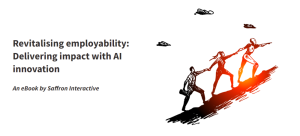My name’s Jasper, and I’m one of the new instructional designers at Saffron Interactive. I’m also an information junkie. I love learning new things, and the more fun I can have while doing that, the better. So with that in mind, I decided to write my first blog post on the subject of apps, play, and flags (you’ll see), and what they can bring to the table in an e-learning, or m-learning, environment.
I’d like to begin my post with a quick moment of reverence for the mobile phone. It’s an astonishing piece of technology. If you’d said to someone a hundred years ago, or even fifty years ago, that soon they would have a device that fits snugly in their pocket, yet is able to access the entire repository of human knowledge in a few seconds, I bet they’d be pretty impressed. But these days it’s something that we take for granted. And it’s something that I want to change. So lately, when I’m waiting for the tube in the morning, rather than scroll through the various social networking sites that now seem to comprise my sense of identity, I have started loading up my Wikipedia app, and hitting the ‘Random article’ button. By doing this I learn something new, interesting, and occasionally arcane (my favourite example is the Dancing Plague of the 16th century; a social phenomenon in which thousands of people became mysteriously compelled to dance until physical exhaustion). And this is all before I’ve even got to my desk.
This is the magic of the mobile phone, and the mobile app. I can stand in the sweltering humidity of the underground, wait for my train, and become completely absorbed in the most peculiar events in human history. It doesn’t feel like ‘learning’ in the same way that school was (technically) learning. But it is. And it’s learning that’s fun, of my own volition, and most importantly, playful.
Apps, in their various forms, are a great facilitator of play. If you want to learn something new, there’s not only an app for that, but there’s a bright and colourful app that will educate you through interactive games, record your progress, and occasionally bombard you with adverts (if you choose to download the free versions, like myself). Just last week I developed a mild addiction to ‘Flags Quiz’. I now know the precise colours, shapes, and designs of many of the world’s symbols of sovereignty (did you know Nepal’s is the only non-quadrilateral flag?).
But enough about flags. You might be asking at this point, ‘why is ‘play’ important in learning?’ Well, the truth is that play isn’t just important in learning, play is learning. In children, play has been shown to enhance social and cognitive skills, improve self-confidence, and develop emotional maturity, while in adults, regular play can result in increased creativity and happiness. Many animals play, and this is often seen by scientists as a vital tool in learning skills for survival. Prey animals such as antelope, zebras, and caribou, play by running and leaping, mimicking the chase of a predator. Contrast this with your everyday household kitten who claws, chases, and swats at balls of twine, in an adorable yet deadly mimesis of mauling its catch.
Now it’s all very good me talking about apps, learning, kittens, and flags, but we have yet to bring it all together. What I’m really trying to say in this post is that apps are a great way of facilitating play, and that play is an incredibly versatile and useful form of practical learning.
Apps can offer a playfulness that simply can’t be mimicked in other learning solutions, and they can aid learning by giving people an opportunity to practise play, something that adults don’t do often enough. One of the most important features of apps in this respect is that their use is both spontaneous and voluntary, and this really is their unique selling point. I don’t use an app because I feel like I have to learn from it. I do it to play, to make my journey quicker, and without extrinsic goals. I end up learning as a by-product, and a consequence of the fun I’m having, not because I feel like I have to.
With this in mind, and as learning professionals, we should embrace the playfulness of the app world. When we develop learning solutions for mobile devices, we need to keep in mind that people will access an app spontaneously and voluntarily. There should be no timings, no timetables, and no supervision. There should be no pressure, no goals, and no objectives. This is learning in its most natural, organic form, and we need to start taking advantage. By ditching the traditional learning structure, and developing solutions that take advantage of this playful platform, we can bring about real behavioural change. Just look at the evidence; I can draw the flags of Burundi, Bahrain and Botswana.





